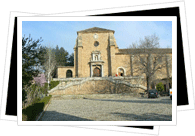Baroque Architecture Background
The restraint and severity of the Herrera-Renaissance architecture was met by the dramatically sensational Baroque architecture. Throughout the 17th and 18th centuries, Baroque structures and decoration dominated the architectural scene- especially in Andalucía.
During an epoch of religious fervor, artwork and architecture during the Baroque period was intended not only to draw attention and be aesthetically stunning, but also to transition the city into having a strong Christian presence. Plus, it served as a means of triumphantly showing off power and control- another reason why Andalucía, land of the final Islamic strongholds, is chock-full of Baroque architecture.
Baroque Architecture Characteristics
 Stylistically, Baroque architecture and decoration was intended to produce tension, grandeur, and unrivalled exuberance- not an easy thing to do in an Islamic city like Granada. Curves replaced straight lines, adornment became elaborate to the poitn fo exaggeration, and a new approach to classic forms was adapted. For example, semicircular frontons- usually a molded triangle or semicircle above a window- were broken and reshaped and columns twisted dramatically, replacing the simple classical columns of the Renaissance.
Stylistically, Baroque architecture and decoration was intended to produce tension, grandeur, and unrivalled exuberance- not an easy thing to do in an Islamic city like Granada. Curves replaced straight lines, adornment became elaborate to the poitn fo exaggeration, and a new approach to classic forms was adapted. For example, semicircular frontons- usually a molded triangle or semicircle above a window- were broken and reshaped and columns twisted dramatically, replacing the simple classical columns of the Renaissance.
Within Baroque architecture there emerged a sub-style called "Churrigueresque," which took decoration to previously unseen degrees. Featuring an exaggerated sumptuousness of adornment, Churrigueresque architecture features tons of surface decoration and heavy use of light and shadow effects.
In Granada, head to the Charterhouse or to the Sacristy of the Cartuja Monastery to see Barroque architecture in all its glory!